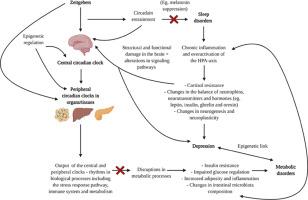Life Sciences ( IF 5.2 ) Pub Date : 2020-11-26 , DOI: 10.1016/j.lfs.2020.118809 Eleni Pitsillou , Julia Liang , Andrew Hung , Tom C. Karagiannis

|
Circadian rhythms are responsible for regulating a number of physiological processes. The central oscillator is located within the suprachiasmatic nucleus (SCN) of the hypothalamus and the SCN synchronises the circadian clocks that are found in our peripheral organs through neural and humoral signalling. At the molecular level, biological clocks consist of transcription-translation feedback loops (TTFLs) and these pathways are influenced by transcription factors, post-translational modifications, signalling pathways and epigenetic modifiers. When disruptions occur in the circadian machinery, the activities of the proteins implicated in this network and the expression of core clock or clock-controlled genes (CCGs) can be altered. Circadian misalignment can also arise when there is desychronisation between our internal clocks and environmental stimuli.
There is evidence in the literature demonstrating that disturbances in the circadian rhythm contribute to the pathophysiology of several diseases and disorders. This includes the metabolic syndrome and recently, it has been suggested that the ‘circadian syndrome’ may be a more appropriate term to use to not only describe the cardio-metabolic risk factors but also the associated comorbidities. Here we overview the molecular architecture of circadian clocks in mammals and provide insight into the effects of shift work, exposure to artificial light, food intake and stress on the circadian rhythm. The relationship between circadian rhythms, metabolic disorders and depression is reviewed and this is a topic that requires further investigation. We also describe how particular proteins involved in the TTFLs can be potentially modulated by small molecules, including pharmacological interventions and dietary compounds.
中文翻译:

昼夜节律机制将代谢紊乱与抑郁症联系起来:途径,蛋白质和潜在药理干预措施的综述
昼夜节律负责调节许多生理过程。中央振荡器位于下丘脑上睑上核(SCN)内,并且SCN通过神经和体液信号与在我们周围器官中发现的生物钟同步。在分子水平上,生物钟由转录-翻译反馈环(TTFL)组成,这些途径受转录因子,翻译后修饰,信号传导途径和表观遗传修饰因子的影响。当在昼夜节律的机器中发生破坏时,与该网络有关的蛋白质的活性以及核心时钟或时钟控制基因(CCG)的表达都可以改变。
文献中有证据表明,昼夜节律紊乱有助于多种疾病和病症的病理生理。这包括代谢综合症,最近有人提出,“昼夜节律综合症”可能是一个更合适的术语,不仅可以用来描述心脏代谢危险因素,还可以用来描述相关的合并症。在这里,我们概述了哺乳动物昼夜节律的分子结构,并提供了对轮班工作,暴露于人造光,食物摄入和压力对昼夜节律的影响的见识。昼夜节律,代谢紊乱和抑郁之间的关系进行了审查,这是一个需要进一步研究的主题。我们还描述了TTFL中涉及的特定蛋白质如何被小分子潜在地调节,










































 京公网安备 11010802027423号
京公网安备 11010802027423号